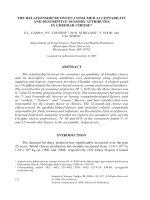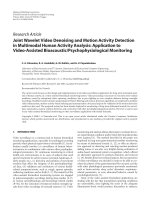Microbial biomass - carbon (SMB-C) and dehydrogenase activity (DHA) in wetland rice ecosystem
Bạn đang xem bản rút gọn của tài liệu. Xem và tải ngay bản đầy đủ của tài liệu tại đây (199.98 KB, 6 trang )
Int.J.Curr.Microbiol.App.Sci (2018) 7(9): 384-389
International Journal of Current Microbiology and Applied Sciences
ISSN: 2319-7706 Volume 7 Number 09 (2018)
Journal homepage:
Original Research Article
/>
Microbial Biomass - Carbon (SMB-C) and Dehydrogenase Activity (DHA)
in Wetland Rice Ecosystem
Prabha Susan Philip1*, R.K. Kaleeswari2 and K. Kumar3
1
ICAR - National Bureau of Soil Survey and Land Use Planning, Regional Centre,
Delhi -110012, India
2
3
Department of Soil Science, Department of Agricultural Microbiology, Tamil Nadu
Agricultural University, Tamil Nadu, India
*Corresponding author
ABSTRACT
Keywords
Soil microbial
biomass carbon,
Dehydrogenase
activity, INM
Article Info
Accepted:
04 August 2018
Available Online:
10 September 2018
A field experiment was conducted in clay loam of Wetlands of TNAU farm, Coimbatore to
study the impact of nutrient management technologies on Soil Microbial Biomass-Carbon
(SMB-C) and Dehydrogenase Activity (DHA) of soil under lowland rice ecosystem. In the
present investigation, integration of inorganics, Sesbania aculeata and biofertilizers have
intensively triggered the microbial activities, which would have resulted in higher
dehydrogenase activity. The better nutrient management leads to better crop productivity
which results in incorporation of larger organic matter through root biomass or leaf fall,
root exudates, etc. thereby influencing the C dynamics in soil. The nutrient level and
moisture play a dominant positive role towards the dehydrogenase activity. The
dehydrogenase activity and biomass carbon content tended to increase with the
advancement in crop growth. The results from the correlation analysis have revealed that
the soil nutrient status has a direct and significant role in enhancing the soil microbial and
enzyme activities. Integrated use of inorganic fertilizers, Sesbania aculeata and Azolla
orchestrates soil nutrient availability, biomass production, biochemical activities and
favorable soil physical environment that facilitate effective carbon sequestration in
lowland rice ecosystem.
Introduction
Microbial activity in a soil drives organic
matter decomposition and mineralization
processes, leading to release of organically
bound plant nutrients in forms available to
growing plants (Izaurralde and Cerre, 2002).
Soil organisms produce extracellular enzyme
and hyphae which hold soil particles and
create aggregates. Soil microbial biomass is
the active component in soil organic matter.
The change in the microbial biomass carbon
reflects the process of microorganism
propagation and degradation utilizing soil
carbon.
It is the centre of majority of biological
activity in soil and therefore, the knowledge of
the microbial biomass carbon is highly
essential.
384
Int.J.Curr.Microbiol.App.Sci (2018) 7(9): 384-389
Lenhard (1956) introduced the concept of
determining the metabolic activity of
microorganisms in soil and other habitats by
measuring dehydrogenase activity. Soil
microbial biomass is more sensitive to
agricultural management than other fractions.
Therefore, the short-term effect of soil
management on soil properties can be
determined by looking at the soil microbial
biomass (Haynes, 1993). The activity of
dehydrogenase is significantly correlated with
soil biomass in organic amended soil (Garcia
Gill et al., 2000).
It plays a significant role in the biological
oxidation of soil organic matter by transferring
protons and electrons from substrates to
acceptors (Glinski et al., 1986). Soil microbial
biomass increased with root growth and
rooting density of the crop. Addition of root
exudates would be least in soil under fallow
rotations and greatest under forage, which is
consistent with biomass results. The better
nutrient management leads to better crop
productivity which results in incorporation of
larger organic matter through root biomass or
leaf fall, root exudates, etc. thereby
influencing the C dynamics in soil 6(Lynch
and Panting, 1980).
Rice occupies a pivotal place in Indian
Agriculture, as it is the staple food for more
than 70 per cent of our population and a
source of livelihood for about 120 to 150
million rural households. In India rice spreads
over an area of about 43.9 million hectares
that accounts for 26.91 per cent of the world's
paddy rice area with total production of 93.88
tonnes. In Tamil Nadu rice cultivation spreads
over an area of 2.10 million hectares with a
total production of 9.3 million tonnes (Policy
note, 2015). The supply of nutrients in the
form of organic manures helps in sustaining
favorable soil physical properties thereby
enhancing the water and nutrient use
efficiencies.
Green manuring is the cheapest locally
available resource for building up soil fertility
and supplementing plant nutrients, especially
N. Green manure is an organic resource offer
the twin benefits of soil quality and fertility
enhancement while meeting a part of nutrient
needs of crops (Vinod Kumar et al., 1999).
The higher reduction in pH, electrical
conductivity and exchangeable sodium
percentage of soil was observed by using
organic manures along with chemical
fertilizers as compared to fertilizers alone
(Yadav and Kumar, 2002). Chelating action of
organic
compounds
released
during
decomposition of organic sources increased
the availability of micronutrients by
preventing
their
fixation,
oxidation,
precipitation and leaching (Yadav and Kumar,
2000). Incorporation of Sesbania aculeata
residue in soil, fixed more atmospheric N
biologically in the soil and also added higher
amount of organic matter which is a good
indicator of soil fertility and improved status
of available nutrients in the soil (Dwivedi et
al., 2005).
Roychowdhry et al., (1979) reported that
Azolla, applied as a dead organic matter,
provides only nitrogen to the crop on
mineralization and does not help in improving
the status of soil aggregation. Singh (1980)
revealed that the cumulative release of
phosphorus was found to be superior in fresh
Azolla incorporation than fresh blue green
algae. Blue green algae which colonize in the
rice fields have been reported to be
responsible for the long term fertility of paddy
fields. The presence of algal symbiont
Anabaena Azollae in its leaf cavities helps in
N fixation and in turn increases soil organic
content in terms of total N after death of the
Azolla plant (Watanabe et al., 1977). On an
average BGA contributes 25-30 kg nitrogen
per hectare per season and leads to 10-15 per
cent increase in rice productivity (Rao and
Burns, 1991).
385
Int.J.Curr.Microbiol.App.Sci (2018) 7(9): 384-389
Materials and Methods
A field experiment was conducted in clay
loam Vertic Ustochrept at Field No. B4 of
Wetlands of TNAU farm, Coimbatore (11o 12’
N and77o 03’E) during 2012 with rice (var.
CO (R) 50), a medium duration rice variety
(130-135 days). The experiment was laid out
in Randomized Block Design (RBD) with
three replications. The plot size was 20 m2 (5
m x 4 m). Initial soil characteristics of the
experimental site were: pH 8.18; electrical
conductivity 0.42 dS m-1 and cation exchange
capacity 19.5 cmol (p+) kg-1, organic carbon
0.63%, available N (216 kg ha-1), available P
(20.4 kg ha-1) and available K (533 kg ha-1)
status.
The DTPA extractable available Fe, Zn, Mn
and Cu were 12.59, 6.00, 11.39 and 4.00 mg
kg-1 respectively. The treatments consisted of
T1 - Untreated control; T2 - 75% RDF
(112.50:37.50:37.50 kg N, P2O5, K2O + 25 kg
ZnSO4 ha-1); T3 - T2 + Sesbania aculeata
@6.25t ha-1; T4 - T3 + Azolla @ 500 kg ha-1;
T5 - T3 + BGA@10 kg ha-1; T6 - 100% RDF
(150:50:50 kg N, P2O5, K2O + 25 kg ZnSO4
ha-1); T7 - T6 + Sesbania aculeata @6.25t ha-1;
T8 - T6 + Azolla@ 500 kg ha-1; T9 - T6 +
BGA@10 kg ha-1.
The microbial biomass carbon was determined
by the incubation and fumigation technique of
Jenkinson and Powlson (1976). The
dehydrogenase activity was measured by the
methodology outlined by 8Casida et al.,
(1964).
Results and Discussion
Correlation between microbial biomass C and
dehydrogenase activity was positive and
highly significant (r = 0.894**). Linear
increase in dehydrogenase activity was
observed with increase in level of inorganic
fertilizers. This observation is in agreement
with the findings of Dhkar and Mishra (1983)
that highlighted the dominant positive role of
nutrient level towards the enzyme activities.
Incorporation of Sesbania aculeata would
have increased the microbial growth and
improved the soil-water-plant relationships.
Irrespective of the level of chemical fertilizers,
combined application of organic manures and
biofertilizers significantly enhanced the
biomass carbon.
The dehydrogenase activity was found to be
significantly increased by nutrient levels,
organic manuring and biofertilizer application.
DHA was significantly higher in 100% RDF +
Sesbania aculeata + Azolla treatment (34.85
μg TPF g-1 soil 24 hr-1). At harvest stage,
application of 100% RDF + Sesbania aculeata
+ Azolla significantly enhanced the
dehydrogenase activity (44.23 μg TPF g-1 soil
24 hr-1) (Table 1). The increased
dehydrogenase activity might be attributed to
the incorporation of Sesbania aculeata, owing
to increase in microbial activity of the soil.
Similar results were reported by Pauscal et al.,
(1998).
Application of 100% RDF + Sesbania
aculeata + Azolla increased the amount of
biomass carbon (435 mg kg-1) (Table 2). The
maximum effect of inputs on the microbial
biomass was realized under 100% RDF +
Sesbania aculeata + Azolla. The lowest
biomass carbon content of 162 mg kg-1 was
recorded in control at harvest stage. The
highest biomass carbon content of 597 mg kg-1
was recorded in treatment 100% RDF +
Sesbania aculeata + Azolla. Gayatri Verma
and Mathur (2009) indicated the integrated
role of FYM and chemical fertilizers in
increasing
microbial
biomass
carbon.
Application of Azolla, besides showing
primary effects, is also known to fix C during
photosynthesis. Photosynthetic efficiency of
Azolla over BGA was also reported by Mie
Mie Aung et al., (2002).
386
Int.J.Curr.Microbiol.App.Sci (2018) 7(9): 384-389
Table.1 Effect of nutrient management strategies on dehydrogenase activity at tillering and
harvest stages of rice crop
Dehydrogenase activity (μg TPF g-1 soil 24
hr-1)
Tillering
Harvest
12.75
21.61
14.73
23.57
17.51
27.06
28.46
36.08
20.64
30.55
18.57
28.22
25.67
34.67
34.85
44.23
29.37
38.14
22.36
31.56
0.71
1.22
1.5
2.6
Treatments
T1- Untreated control
T2- 75% RDF
T3- 75% RDF + Sesbania aculeata
T4 -75% RDF + Sesbania aculeata + Azolla
T5-75% RDF + Sesbania aculeata + BGA
T6 -100% RDF
T7 - 100% RDF + Sesbania aculeata
T8- 100% RDF + Sesbania aculeata + Azolla
T9- 100% RDF + Sesbania aculeata + BGA
Mean
SEd
CD (5%)
Table.2 Effect of nutrient management strategies on soil microbial biomass carbon at tillering
and harvest stages of rice crop
Biomass carbon(mg kg-1)
Tillering
Harvest
90
162
135
217
190
262
310
400
254
326
174
318
260
404
435
597
387
513
248
355
10.58
9.39
22.43
19.90
Treatments
T1- Untreated control
T2- 75% RDF
T3- 75% RDF + Sesbania aculeata
T4 -75% RDF + Sesbania aculeata + Azolla
T5-75% RDF + Sesbania aculeata + BGA
T6 -100% RDF
T7 - 100% RDF + Sesbania aculeata
T8- 100% RDF + Sesbania aculeata + Azolla
T9- 100% RDF + Sesbania aculeata + BGA
Mean
SEd
CD (P=0.05)
Correlation coefficients between soil microbial biomass carbon (S-MBC) and
dehydrogenase activity (DHA)
DHA
0.894**
SMBC
**
Correlation significant at P = 0.01; *Correlation significant at P = 0.05
387
Int.J.Curr.Microbiol.App.Sci (2018) 7(9): 384-389
Incorporation of Sesbania aculeata in
combination with RDF and with RDF +
Azolla or BGA increased the microbial
biomass carbon compared to that of inorganic
fertilizers alone. These observations are in
accordance with the findings of Haiyan Chu
et al., (2007), Khosro Mohammadi (2011) and
Neetu Pareek and Yadav (2011).
soil microbial and enzyme activities.
Integrated use of inorganic fertilizers,
Sesbania aculeata and Azolla orchestrates soil
nutrient availability, biomass production,
biochemical activities and favorable soil
physical environment that facilitate effective
carbon sequestration in lowland rice
ecosystem.
The soil microbial biomass acts as the
transformation agent of the organic matter in
the soil. As such, the biomass is both a source
and sink of the carbon, nitrogen and
phosphorus contained in organic matter.
Generally, soil microbial biomass is more
dynamic fraction of soil organic C.
Dehydrogenase activity is only present in
viable cells; it is thought to reflect the total
range of oxidative activity of soil microflora
and consequently may be considered to be a
good indicator of microbial activity. The
nutrient level and moisture play a dominant
positive role towards the dehydrogenase
activity. In the present investigation,
integration of inorganics, Sesbania aculeata
and biofertilizers have intensively triggered
the microbial activities, which would have
resulted in higher dehydrogenase activity.
Buildup of microbial biomass would be
mainly due to the microbial biomass
contained in the organic residues and the
addition of substrate carbon, which stimulates
the indigenous soil micro-biota. Moreover,
the supply of additional mineralizable and
readily hydrolysable C due to the
incorporation of Sesbania aculeata resulted in
higher microbial activity and thereby
microbial
biomass
carbon.
The
dehydrogenase activity and biomass carbon
content tended to increase with the
advancement in crop growth. This might be
due to the increased root and shoot biomass
production at later stages of crop growth. The
results from the correlation analysis have
revealed that the soil nutrient status has a
direct and significant role in enhancing the
Acknowledgements
This research work was carried out during
'Masters Degree Programme'. The first author
is thankful to Indian Council of Agricultural
Research (ICAR) for the grant of junior
research fellowship during the entire course
of research. The authors are thankful to Tamil
Nadu Agricultural University for the all
facilities and amenties provided during the
course of work.
References
Casida, L. E. Jr., D.A. Klein and T. Santoro.
(1964). Soil dehydrogenase activity.
Soil Science, 98: 371-376.
Dhkar, M.S. and R.R. Mishra. 1983.
Dehydrogenase and urease activities of
maize (Zea mays L.) field soils. Plant
and Soil, 70: 327-333.
Garcia-Ruiz, R., V. Ochoa., M. Bales
Hinojosa and J.A. Carrcira. (2008).
Suitability of enzyme activity for the
monitoring of soil quality improvement
in organic agricultural system. Soil
Biology and. Biochemistry, 40: 21372145.
Gayatri Verma and A.K. Mathur. (2009).
Effect
of
integrated
nutrient
management on active pools of soil
organic matter under maize-wheat
system of a Typic Haplustalf. Journal of
Indian Society Soil Science, 57(3): 317322.
Glinski, J., Z. Stepniewska, and M.
Brzezinska. (1986). Characterization of
388
Int.J.Curr.Microbiol.App.Sci (2018) 7(9): 384-389
the dehydrogenase and catalase activity
of the soils of two natural sites with
respect to the soil oxygenation status.
Polish Journal of Soil Science, 19:4752.
Haiyan Chu, Xiangui Lin, Takeshi fujii, Sho
Morimoto, Kazuyuki Yagi, Junli Hu,
Jiabao Zhang. (2007). Soil microbial
biomass,
dehydrogenase
activity,
bacterial community structure in
response to long term fertilizer
management.
Soil
Biology
and
Biochemistry, 39: 2971-2976.
Haynes, R.J. (1993). Effect of sample
pretreatment on aggregate stability
measured
by
wet
sieving
or
turbidimetry on soils of different
cropping history. Journal of Indian
Society Soil Science, 44: 261-270.
/>milNadu/Policy_note_agriculture_201516.pdf
Izaurralde, R. C. and C.C. Cerri.
(2002).Organic matter management. In:
Encyclopedia of Soil Science (ed. Lal,
R.), Marcel Dekker, New York, pp.
910–916.
Jenkinson, D.S. and D.S. Powlson (1976).
The effects of biocidal treatments on
metabiolism in soil – A method for
measuring soil biomass. Soil Biology
and Biochemistry, 8: 209-213.
Khosro Mohammadi. (2011). Soil microbial
activity and biomass as influenced by
tillage and fertilization in wheat
production.
AmericanEurasian
Journal
of
Agriculture
and
Environmental Science, 10(3): 330-337.
Lenhard, G. (1956). The dehydrogenase
activity in soil as a measure of the
activity of soil microorganisms. Z.
Pflancenernaehr. Dueng. Bodenkd. 73:
1-11.
Lynch, J.M. and L.M. Panting. 1980.
Cultivation and the soil biomass. Soil
Biology and Biochemistry, 12: 29-33.
Mie Mie Aung, Ulrich Eberhardt, L.G.P.
Vlek. (2002). International Conference
on challenges to organic farming and
sustainable land use in the tropics and
sub tropics held at University of Kansas
– Witzenhausen.
Neetu Pareek and B.L. Yadav. (2011). Effect
of organic manures on soil physico
chemical properties, soil microbial
biomass and yield of mustard under
irrigation of different residual sodium
carbonate waters. Journal of Indian
Society Soil Science, 59(4): 336-342.
Pauscal, J.A., T. Hernandez, C. Garcia and M.
Ayuso. (1998). Enzymatic activities in
an arid soil amended with urban organic
wastes.
Laboratory
experiments.
Bioresource Technology, 64: 131-138.
How to cite this article:
Prabha Susan Philip, R.K. Kaleeswari and Kumar, K. 2018. Microbial Biomass - Carbon
(SMB-C) and Dehydrogenase Activity (DHA) in Wetland Rice Ecosystem.
Int.J.Curr.Microbiol.App.Sci. 7(09): 384-389. doi: />
389









